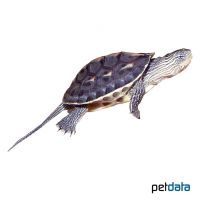Chinese Striped-necked Turtle (Mauremys sinensis)
| Chinese Striped-necked Turtle Mauremys sinensis | |
|---|---|
| Name | Chinese Striped-necked Turtle |
| Name Lat. | Mauremys sinensis |
| Synonym | Ocadia sinensis |
| Family | Asian River Turtles |
| Family lat. | Geoemydidae |
| Order | Turtles |
| Order lat. | Testudines |
| Origin | Southeast Asia |
| Habitat | Shallow waters |
| Diet | Insects, fish, plant matter |
| Humidity | 60-80 % |
| Behavior | Peaceful |
| Keeping | Individual, group |
| Care Level | Moderate |
| Reproduction | Oviparous |
| Housing | Aquaterrarium |
| Life Span | 20 years |
| Protection | CITES Appendix III; EU Annex C |
| Metric Units | |
| Size | 24 cm |
| Temperature | 25-28 °C |
| Temperature Local | 35-40 °C |
| Housing Size | 120 x 60 x 50 cm |
| US Units | |
| Size | 9.4" |
| Temperature | 77-82 °F |
| Temperature Local | 95-104 °F |
| Housing Size | 45" x 25" x 20" |
Distribution and habitat
The distribution area of the Chinese Striped Turtles is southern China, Hainan and Taiwan to central Vietnam. They live in slow flowing and stagnant waters with soft bottoms and dense vegetation, as well as sheltered sunning areas on the shores.
Maintenance
Minimum dimensions for the aquaterrarium, according to the size and number of animals
| floor space for 1-2 animals: 5PL x 2,5PL (L x W) | Water level: 2PB |
The carapace length (PL) and carapace width (PB) is measured on the largest animal. For each additional animal, increase the footprint by 10%, and for the 5th animal and larger, increase the footprint by 20%. An aquaterrarium of e.g. 120 x 60 x 50 cm is recommended, which should be placed in a quiet place
The water part, about two thirds of the base area, should be structured with a soft substrate of fine gravel, with roots, aquatic plants and larger stones (hiding places), some of which reach the water surface. The water depth should not exceed twice the carapace width of the animals. The terrestrial part with a substrate of soft sand-earth mixture should be equipped with robust plants and roots as well as offer sunning places. To maintain water quality, a powerful filter with low flow and frequent water changes are recommended.
| Temp. day: 25-28 °C | Temp. night: 18-20 °C | Temp. local: 35-40 °C | Water temp.: 22-28 °C |
The lighting duration should be 8-14 hrs. depending on the season. They need daily UV irradiation and sunny places with radiant heat.
Diet
They are omnivores and require a balanced mix of animal and plant foods. The food supply consists of commercial water turtle food, supplemented with insect larvae, mussels, snails, small crustaceans, earthworms, fish pieces, etc., which are also well accepted frozen. In addition, with advancing age, they absolutely need vegetable food, such as lettuce, dandelion and tender water plants. Also sweet fruit (e.g. banana) is eaten, individually different. The regular addition of minerals and vitamins is important
At least 1-2 fasting days per week are recommended. A varied diet promotes health and prevents deficiency symptoms.
Reproduction and breeding
The much smaller males have a concave ventral carapace and the anal opening is closer to the tip of the tail than in the female.
The eggs, 3-12 per clutch, are buried on land in soft sandy substrate. The incubation period is about 55 days at a temperature of 28 °C
Life expectancy can be over 20 years.
Species protection
Species protection: WA Appendix III; EU Appendix C. The animal population is not yet acutely endangered, but is under surveillance in China. Your pet store will be happy to provide you with further information.
Important
The air temperature must always be at least 2-3 °C higher than the water temperature. It is important that the animals can dry in their sunny spot.
For the 6-8 week winter resting period, the temperature is lowered to 12-15 °C and the lighting time is reduced by 2-3 hours. Winter dormancy can be done in water or soil-moist substrate. The animals can be kept in an outdoor facility during the warm summer months.
The terrarium must have good ventilation without drafts and meet the species specific needs. Measuring devices such as thermometers, hygrometers, etc. are necessary. The lighting has to correspond to the species-specific day-night rhythm and has to be placed in such a way that the animals cannot injure themselves. The terrarium should be locked in such a way that neither unauthorized persons can open it nor the animals can escape. Contamination must be removed regularly
Further literature can be found in your pet store.
References
Text: Christian Sänger; Image: petdata
Source: BMELV (1997): Tierschutzgutachten - Mindestanforderungen an die Haltung von Reptilien; ENGELMANN (2006): Zootierhaltung - Tiere in menschlicher Obhut: Reptilien und Amphibien, Harri Deutsch Verlag
- Gemäß § 21 Abs. 5 Tierschutzgesetz idgF
